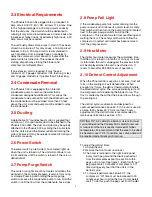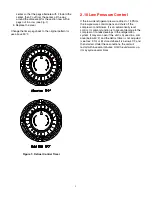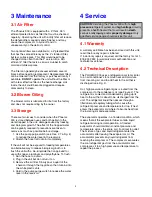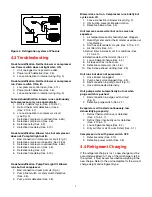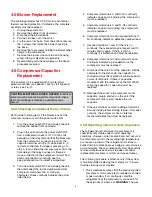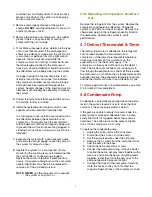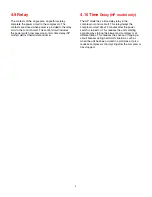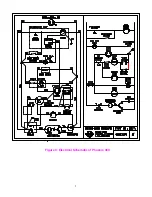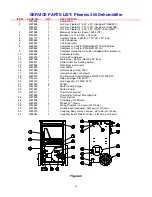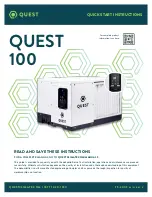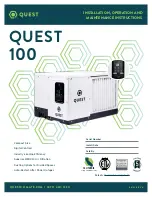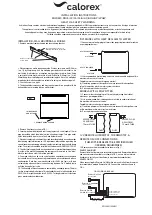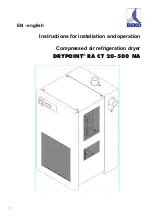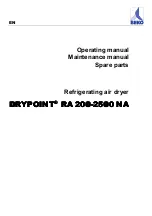
7
could be toxic and highly acidic. If no acid odor is
present, skip down to the section on changing a
non-burn out compressor.
2. Remove and properly dispose of the system
charge.
DO NOT
vent the refrigerant or allow it to
contact your eyes or skin.
3. Remove the burned out compressor. Use rubber
gloves if there is any possibility of coming in
contact with the oil or sludge.
4. To facilitate subsequent steps, determine the type
of burn out that occurred. If the discharge line
shows no evidence of sludge and the suction line
is also clean or perhaps has some light carbon
deposits, the burn out occurred while the
compressor was not rotating. Contaminants are
therefore largely confined to the compressor
housing. A single installation of liquid and suction
line filter/driers will probably clean up the system.
If sludge is evident in the discharge line, it will
likely be found in the suction line; this indicates
the compressor burned out will running. Sludge
and acid have been pumped throughout the
system. Several changes of the liquid and suction
filter/driers will probably be necessary to cleanse
the system.
5) Correct the system fault that caused the burn out.
Consult the factory for advice.
6) Install the replacement compressor with a new
capacitor and an oversized liquid line filter.
In a running burn out, install an oversized suction
line filter/drier between the accumulator and
compressor. Thoroughly flush the accumulator
with refrigerant to remove all trapped sludge and
to prevent the oil hole from becoming plugged. A
standing burn out does not require a suction line
filter/drier.
7) Evacuate the system with a good vacuum pump
and accurate vacuum gauge. Leave the pump on
the system for at least an hour.
8) Operate the system for a short period of time,
monitoring the suction pressure to determine that
the suction filter is not becoming plugged.
Replace the suction filter/drier if pressure drop
occurs. If a severe running burn out has occurred,
several filter/driers may have to be replaced to
remove all of the acid and moisture.
NOTE: NEVER
use the compressor to evacuate
the system or any part of it.
4.6C Replacing a Compressor- Non-Burn
Out
Remove the refrigerant from the system. Replace the
compressor and liquid line filter/drier. Charge the
system to 50 PSIG and check for leaks. Remove the
charge and weigh in the refrigerant quantity listed on
the nameplate. Operate the system to verify
performance.
4.7 Defrost Thermostat & Timer
The defrost thermostat is attached to the refrigerant
suction tube between the accumulator and
compressor. If the low side refrigerant temperature
drops due to excessive frost formation on the
evaporator coil, the thermostat opens. The
compressor is then cycled off and on by the defrost
timer. The blower will continue to run, causing air to
flow through the evaporator coil and melt the ice when
the compressor is off. When the air temperature and/or
humidity increase, the evaporator temperature will rise
and the thermostat will close to end the defrost cycle.
To improve performance in low temperatures, see Sec.
2.9 for defrost timer adjustment.
4.8 Condensate Pump
Condensate is automatically pumped when the water
level in the pump's reservoir rises to close the float
switch or if the pump purge switch is held in.
If the pump is unable to empty its reservoir due to a
pump failure or blocked condensate hose, a pump
safety float switch is triggered before the reservoir
overflows. The switch turns on the pump fail light &
turns off the compressor via its relay.
To replace the condensate pump:
1.
Unplug the unit & remove the front cover.
2.
Disconnect the 2 hoses from the pump.
3.
Cut the pump lead wires near the old pump.
4.
Remove the 4 screws from the unit bottom that
hold the pump to the base.
5.
Attach the new pump with 4 screws.
6.
Connect the new pump wiring. It may be easier
to splice the new & old gray leads together with a
wire nut, and splice the new & old yellow leads
together, rather than route the new ones to the
pump purge switch & pump fail light.
7.
Connect the hoses to the new pump. Carefully
route the hoses so they do not contact the
copper refrigerant lines or the compressor shell.


